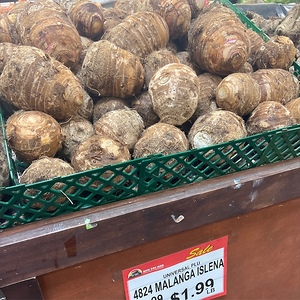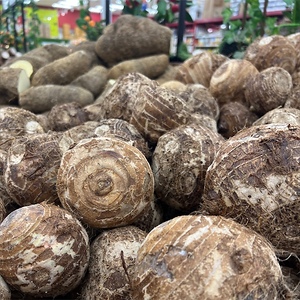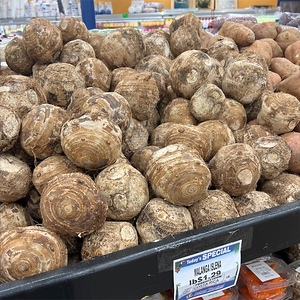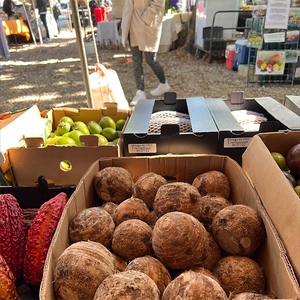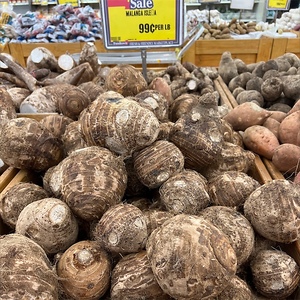

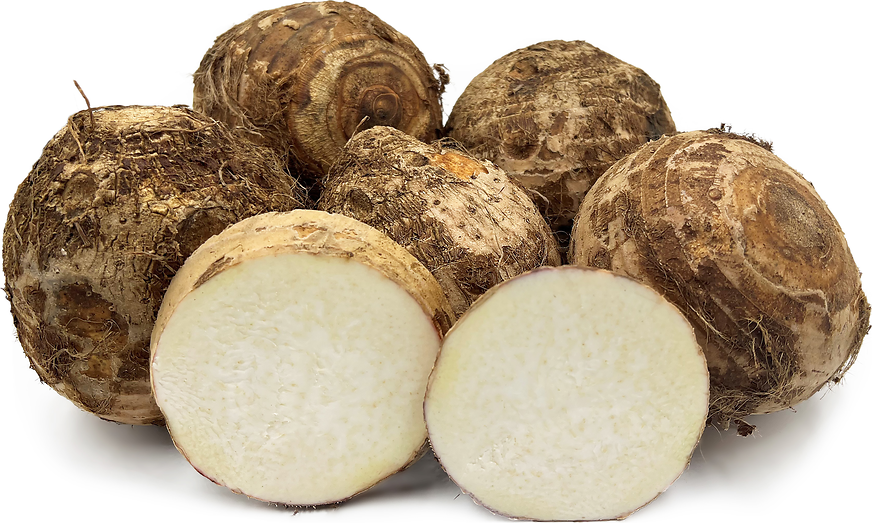
Malanga Islena
Estimated Inventory, lb : 0
Description/Taste
Malanga Isleña corms widely vary in appearance, depending on cultivation time, soil, and climate, and range from small to large, growing in a round to oblong shape. Each plant generally produces one central corm, and the corm’s variegated dark to light brown skin is rough with an uneven, scaly texture comprised of faint horizontal rings and fiber-like hairs. Underneath the surface, the flesh is dense, dry, and starchy, primarily white with subtle brown speckling. Malanga Isleña corms must be cooked and develop a smooth, thick, and semi-fluffy consistency. The flesh has a mild, earthy, sweet, and nutty flavor with musky nuances that some liken to the taste of black walnut. In addition to the corms, the young leaves are edible when cooked, providing a vegetal, grassy, and green flavor.
Seasons/Availability
Malanga Isleña is available year-round.
Current Facts
Malanga Isleña, botanically classified as Colocasia esculenta, are edible corms of a tropical, evergreen plant belonging to the Araceae family. The corms grow below ground, sprouting upright stalks with large, arrow-shaped leaves, and the plants are found in tropical to subtropical regions worldwide, celebrated for their ease of cultivation and edible nature. Malanga Isleña is also known as Yautia Isleña, Island Malanga, and Yautia Coco and is a variety of taro primarily localized to the Caribbean and Caribbean coastal regions of Central America. Isleña means “island” in Spanish and is a descriptor for the corm’s prevalent use as a staple tropical vegetable. Despite its malanga title, Malanga Isleña is a type of taro distinct from other malanga varieties such as yellow malanga and white malanga. Taro and malanga belong to the same botanical family, but they are a part of different genuses. Malanga Isleña is prepared similarly to potatoes or yams and is a central component to everyday Central American and Caribbean cuisine.
Nutritional Value
Malanga Isleña is an excellent source of fiber to regulate the digestive tract, a good source of vitamin C to strengthen the immune system, potassium to balance fluid levels within the body, and contains other nutrients, including vitamins B6 and E, zinc, iron, phosphorus, manganese, copper, and magnesium. In addition to the corms, the leaves are a source of vitamins A and C, which provide antioxidants to protect the body against external aggressors and free radical damage. Beyond vitamins and minerals, Malanga Isleña contains calcium oxalate crystals that cause irritation to the throat and mouth. These crystals are considered toxic in raw corms and are neutralized in cooking or drying.
Applications
Malanga Isleña must be cooked before consumption as it contains calcium oxalate crystals. These tiny crystals can cause extreme irritation to the throat and mouth if ingested and are considered toxic in the corm’s raw state. When the corms are heated, the crystals will dissipate with cooking. It is also recommended to wear gloves while handling the flesh raw, as it can sometimes cause minor irritation to the skin and hands. Malanga Isleña is a popular ingredient throughout the Caribbean and is used similarly to sweet potatoes and other root vegetables. The corms are traditionally peeled, sliced, and boiled, added to dishes as a thickener. Boiled Malanga Isleña can be mixed into pasta and rice, tossed into stews and curries, mashed with butter and cream, or sliced and baked into chips. The boiled corms can also be combined with coconut to create a creamy soup, incorporated into gratins, or coated in a sweet tomato sauce and served with fish. In Cuba, Malanga Isleña is commonly cooked into caldosa Cubana, a chicken soup with sofrito and a variety of root vegetables. Try cooking Malanga Isleña into hearty beef dishes to add texture and flavor or serving with seafood such as fish. One of the most well-known ways to cook Malanga Isleña is to boil, shred, and fry the corms into fritters. In Puerto Rico, the fritters are known as alcapurria and are made with mashed green bananas and corms stuffed with meat. In Cuba, simple fritters made from the corm are called frituras de malanga. Beyond cooking Malanga Isleña, the corms can be dried, ground into a powder, and made into flour for desserts, main dishes, and baby food. The young leaves are also edible when cooked and can be added to soups, salads, sauces, pasta, and grain bowls. Malanga Isleña pairs well with tomatoes, corn, squash, sweet potatoes, plantains, bell peppers, limes, meats such as chorizo, ham, poultry, and beef, aromatics including garlic, onion, chile peppers, and shallots, spices such as cumin, allspice, paprika, and cloves, and herbs including parsley, cilantro, and oregano. Whole, unwashed, unpeeled Malanga Isleña should be used immediately for the best quality and flavor. When stored in a cool, dark place, the corm will keep for a few days. It is not recommended to store in the refrigerator.
Ethnic/Cultural Info
Malanga Isleña is one of several taro varieties consumed as a staple food source throughout the Caribbean. Taro, also known as dasheen and blue food, is considered a ground provision crop that has been grown on the Caribbean Islands since the 16th century. The plant was initially selected for its resistance to weather change, adaptability to wet and dry soils, and ability to maintain nutrients in the soil without excess care. Over time, taro became valued for its small carbon footprint, as the entire plant is edible, including the corms, stems, and leaves. Historically, taro was never a widely promoted crop, but the corm’s dependable reputation eventually led the island of Tobago to market the plant. In 1997, the Department of Tourism partnered with L’Anse Fourmi, a rural coastal village, and established the Blue Food Festival to increase food tourism. The first festival had around 100 attendees, and residents sold a wide array of baked goods, main dishes, and appetizers incorporating taro. The celebration continued to grow in the following years, eventually becoming so large that it was moved to the nearby community of Bloody Bay. The Blue Food Festival became one of the most famous food festivals of the Caribbean and has received international recognition for its celebration of taro-based products. During the festival, corm-based dishes such as fritters, banana bread, flour, sauces, ice cream, and seafood are sampled to visitors. Callaloo is also served, Trinidad and Tobago’s national food, and this earthy, savory dish is comprised of taro leaves steamed into a stew-like dish.
Geography/History
Malanga Isleña is a descendant of ancient taro varieties native to Southeast Asia and India and has been growing wild for thousands of years. The plants thrive in tropical to subtropical regions and were spread in the early ages across Southern Asia into Northern Africa, China, and Burma. Taro was also carried into Polynesia and was later planted throughout the Pacific through Polynesian and Micronesian voyagers. Over time, Taro continued to spread worldwide, establishing in Western Africa, and enslaved Africans brought the plants with them on voyages across the Trans-Atlantic into the Caribbean on slave ships. The plants were quickly spread throughout the islands and were further carried into Central and South America. Malanga Isleña is considered an old variety, having been cultivated for several centuries, and the corm is widely grown throughout the Caribbean and in Central America, specifically Costa Rica. It is also sold in Southern Florida. Malanga Isleña can be found through local markets, grocers, and distributors.



